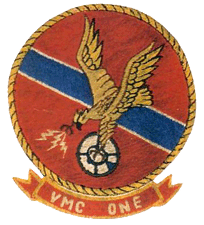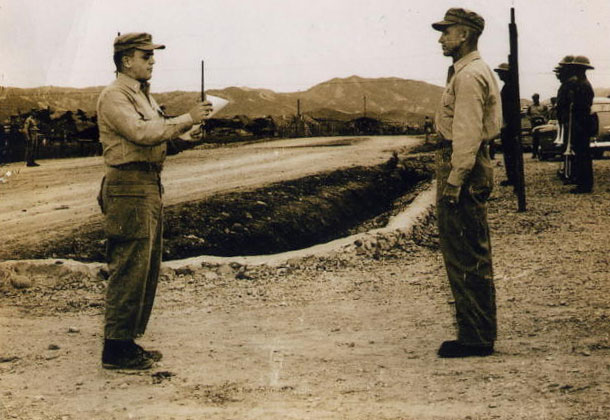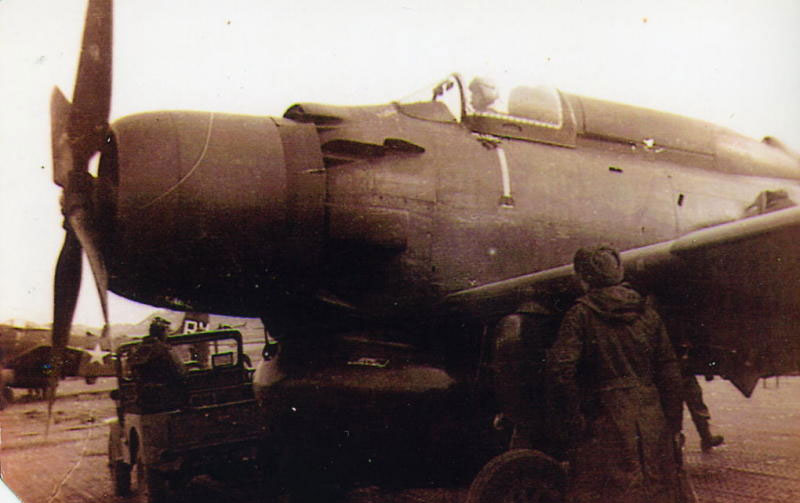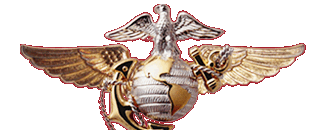MCARA Units > VMC-1 (1952-1958)
Marine Composite Squadron One (VMC-1) History
VMC-1 was commissioned at K-3 Pohang, Republic of Korea on 15 September 1952 about 15 months after an ECM Section under 1st MAW’s HEDRON-1 was formed and later moved to MACG-2. VMC-1 would be the first USMC squadron in combat with a composite mission included both Airborne Early Warning (AEW) and Electronic Counter Measures (ECM), although the focus was the new warfare area of ECM. VMC-1 remained under MACG-2, and was assigned a Navy unit designation of TU 91.10.4. The first CO was Lt. Col. Lawrence F. Fox, who had tours in WW II with an infantry unit and as CO of VMB-612. Of note, he had recently served as Electronics Officer on the staff of the Director of Aviation, HQMC. At stand up the squadron consisted of 17 officers and 46 enlisted, most of whom were already in place at MACG-2. The commissioning order was presented to Lt. Col. Fox by BGen Kriser 1st MAW AWC at a formation depicted in the featured photo. Oddly at stand up, the squadron had only one aircraft assigned, a two seat AD-2Q modified with an AN/APA-17 direction finder.
 Lt. Col. Fox faced a daunting challenge as he was charged with forming a squadron in a war zone with a new mission without benefit of a TO let alone a training pipeline for ECM operators and technicians. Further, he was to be assigned at least 4-5 variants of the AD Skyraider aircraft with few parts, associated tools or maintenance equipment, and each one had to have some in house mods. He was of course expected to rapidly build up his combat capability and begin flying missions as soon as possible. He also had to deal with a steady stream of high level visitors from the Air Force and Navy as well the Marine Corps, all anxious to know what this new squadron was about and of course offering lots of advice. The CMC, General Shephard was one of the first visitors. Lt. Col. Fox in turn along with some of his officers and SNCO’s established liaison with other operational units and intelligence activities they would interface with in the future. Experiencing growing pains would be a gross understatement describing the first 90 days of VMC-1!
Lt. Col. Fox faced a daunting challenge as he was charged with forming a squadron in a war zone with a new mission without benefit of a TO let alone a training pipeline for ECM operators and technicians. Further, he was to be assigned at least 4-5 variants of the AD Skyraider aircraft with few parts, associated tools or maintenance equipment, and each one had to have some in house mods. He was of course expected to rapidly build up his combat capability and begin flying missions as soon as possible. He also had to deal with a steady stream of high level visitors from the Air Force and Navy as well the Marine Corps, all anxious to know what this new squadron was about and of course offering lots of advice. The CMC, General Shephard was one of the first visitors. Lt. Col. Fox in turn along with some of his officers and SNCO’s established liaison with other operational units and intelligence activities they would interface with in the future. Experiencing growing pains would be a gross understatement describing the first 90 days of VMC-1!
The first combat mission for VMC-1 was on 18 September with Major Bagnall and TSgt. Flashner as the crew for the AD-2Q. It was passive Elint or reconnaissance mission but no signals of interest in the targeted “L” band were reported. The next two missions would not occur until 2 October due to aircraft availability problems. Later in October, escort missions were flown in F7F aircraft from HEDRON-1 by VMC-1 crews. As of 31 October, the squadron had 7 aircraft, 14 Naval Aviators, and a total of 82 enlisted.
 The training of operators for the ECM mission was a problem that had plaqued the former ECM section. With VMC-1 it became a major operational obstacle with the influx of enlisted aircrews into the squadron, many coming from the F7F night fighter squadrons as they transitioned to the F3D-2 jets. Most were not electronics technicians as was the case for the initial ECMOs. A training syllabus was written for both pilots and ECMOs, but ECMO training was hampered by lack of multi-place aircraft with more than one ECMO position. The AD-2Q was only a two seater and although the newly assigned AD-4Ns and AD-4NLs were 3 seaters, they too had only one ECM position.. Ground training required the use of the maintenance test benches which interfered with repair work and was no substitute for airborne training. The answer was to come with a plan to convert the squadron’s first AD-4NL into a dual position ECM aircraft, which was one of Lt. Col. Fox’s first decisions. The modification plan was presented by TSgt. Dan Georgia, his most experienced electronic technician and pioneer ECMO, who was sent to Itami, Japan to oversee the conversion. (See AD-4NL history for details). This prototype dual ECMO aircraft with side number RM-1 was first flown on a combat mission on 18 November, 1952 and became an invaluable training asset and model for future aircraft modifications.
The training of operators for the ECM mission was a problem that had plaqued the former ECM section. With VMC-1 it became a major operational obstacle with the influx of enlisted aircrews into the squadron, many coming from the F7F night fighter squadrons as they transitioned to the F3D-2 jets. Most were not electronics technicians as was the case for the initial ECMOs. A training syllabus was written for both pilots and ECMOs, but ECMO training was hampered by lack of multi-place aircraft with more than one ECMO position. The AD-2Q was only a two seater and although the newly assigned AD-4Ns and AD-4NLs were 3 seaters, they too had only one ECM position.. Ground training required the use of the maintenance test benches which interfered with repair work and was no substitute for airborne training. The answer was to come with a plan to convert the squadron’s first AD-4NL into a dual position ECM aircraft, which was one of Lt. Col. Fox’s first decisions. The modification plan was presented by TSgt. Dan Georgia, his most experienced electronic technician and pioneer ECMO, who was sent to Itami, Japan to oversee the conversion. (See AD-4NL history for details). This prototype dual ECMO aircraft with side number RM-1 was first flown on a combat mission on 18 November, 1952 and became an invaluable training asset and model for future aircraft modifications.
By November, the squadron was flying an average of one ECM combat mission and two training missions per day and provided their own AD escorts. The squadron’s ECM school was progressing with each new ECMO receiving 32 hours of night school and 5 flight hours. Although all of the combat missions were passive ELINT or reconnaissance to detect, classify and locate enemy radars, a few chaff drop training missions were conducted against a friendly radar. The MX-900 chaff dispenser proved unreliable and chaff was not used against North Korean radars nor were jammers employed. The passive ECM missions were flown on prescribed tracks up the East and West coasts of North Korea and along the DMZ at an altitude of 10,000 feet between two visually located points. Occasionally, an overland flight in and around Pyongyang were flown. The ADs carried a 150 gallon centerline drop tank which gave them well over 4 1/2 hours endurance. Over time the number of active radars intercepted dropped off as the aircraft crossed the DMZ as the North Koreans recognized their routine tracks. This changed rapidly if a pilot made an unauthorized staffing pass as the gun laying radars were quick to react. No aircraft were lost but on several missions up near the border on the Yalu river Migs chased them back South.
 The squadron was rarely tasked to conduct AEW missions although they had the AD-4W guppy variants assigned with the APS-20 radar, and maintained aircrew proficiency through training missions. However, in late April, 1953 the squadron was tasked to help stop nuisance night attacks by slow flying PO-2 biplanes dropping mortars or small bombs on Kimpo airfield, the USAF F-86 base. A detachment of two AD-4Ns equipped with an APS-31 air search radar was sent to Kimpo and began nightly patrols. The missions were difficult as they had to fly at low altitude close to stalling speed with the gear down! To make matters worse they were often shot at by friendly AAA. However, the crew of Major George Linnemeier and CWO Vern Kramer a former RIO was credited with a kill and another crew got a possible.
The squadron was rarely tasked to conduct AEW missions although they had the AD-4W guppy variants assigned with the APS-20 radar, and maintained aircrew proficiency through training missions. However, in late April, 1953 the squadron was tasked to help stop nuisance night attacks by slow flying PO-2 biplanes dropping mortars or small bombs on Kimpo airfield, the USAF F-86 base. A detachment of two AD-4Ns equipped with an APS-31 air search radar was sent to Kimpo and began nightly patrols. The missions were difficult as they had to fly at low altitude close to stalling speed with the gear down! To make matters worse they were often shot at by friendly AAA. However, the crew of Major George Linnemeier and CWO Vern Kramer a former RIO was credited with a kill and another crew got a possible.
By the end of the war in July, 1953 the squadron would have 11 AD Skyraiders assigned, 6 modified for ECM including AD-2Qs, AD-3Ns, and AD-4N/NLs, four AD-4Ws and one straight attack aircraft. Personnel strength had reached 29 officers and 167 enlisted.
After the Korean War ended the squadron remained there for two more years conducting electronic reconnaissance missions along the DMZ. In June, 1955 the squadron moved to MCAS Kaneohe Bay in Hawaii, dropping all of the assigned aircraft in Japan. Upon arrival in Hawaii, VMC-1 picked up AD-5Ns, an upgraded two-place Skyraider for the ECM mission and the AD-5W Guppy radar version. The squadron settled in to routine training operations which included participation in many exercises. A long distance training flight to Midway Island, some 1100 nautical miles was reported. The squadron lost 3 aircraft during its tour in Hawaii with 4 crewmembers perishing. In July,1958 the squadron was ordered to the mainland and stationed at MCAS El Toro in Southern California. Its sister squadrons VMC-2 and 3 had become composite reconnaissance squadrons in December, 1955 and VMC-1 made that transition on 31 July, 1958, merging with VMJ-1 to become VMCJ-3.
(Write up by Col H. Wayne Whitten USMC (ret) from VMC-1 Command Diaries, an article by then Major Daniel C. Georgia on VMC-1 origins, and excerpts from Top Secret by J. T. O’Brien)


